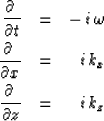




Next: Snell waves
Up: THE PARAXIAL WAVE EQUATION
Previous: Why the wave equation
Start from the dispersion relation of the scalar wave equation:
|  |
(31) |
Take a square root.
|  |
(32) |
The simple act of selecting the minus sign in (32)
includes the upcoming waves
and eliminates the downgoing waves.
Equation (31) is the three-dimensional Fourier transform of
the scalar wave equation.
Inverse transforming (32) will give us an equation for
upcoming (or downgoing) waves only, without the other.
Inverse Fourier transformation over a dimension is just a matter
of selecting one or more of the following substitutions:
|  |
(33) |
| (34) |
| (35) |
After inverse transformation over z there is a differential
equation in z in which the velocity may be taken to be z-variable.
Likewise for x.
Any equation resulting from any of the substitutions of (33),
(34) and (35) into
(32) is called a paraxial equation.
Here we will go into great detail about the
meaning of these equations.
Before beginning this interpretation
the paraxial wave equation will be derived
without the use of Fourier transformation.
Besides giving a clear path to the basic migration equation,
this derivation also gives a better understanding
of what the equation really does,
and how it differs from the scalar wave equation.





Next: Snell waves
Up: THE PARAXIAL WAVE EQUATION
Previous: Why the wave equation
Stanford Exploration Project
10/31/1997
